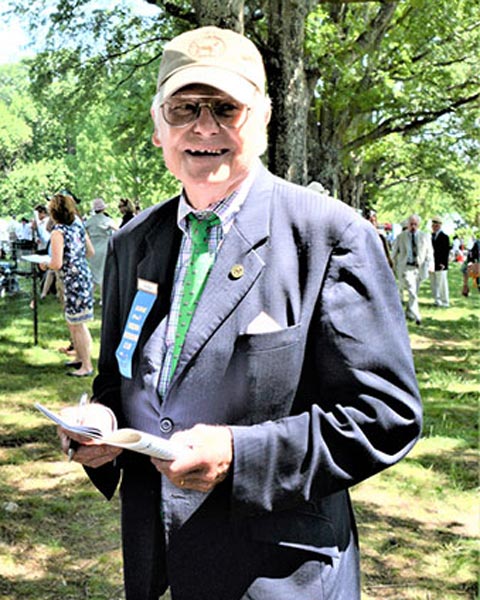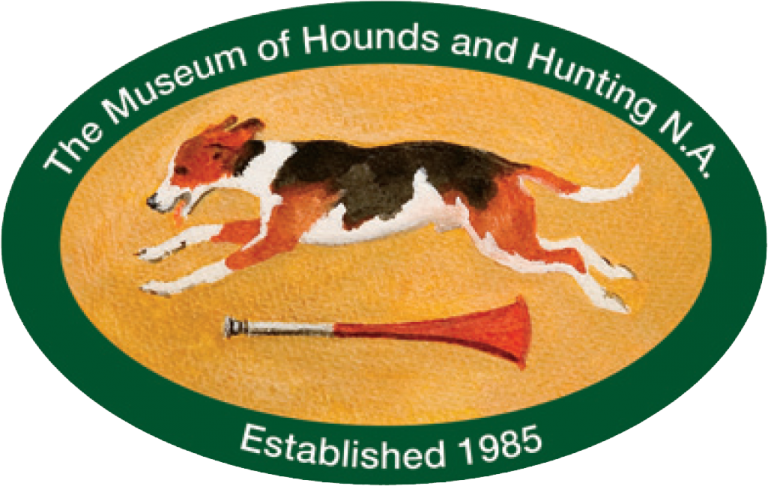Museum Founder – John J. Carle II, ex-MFH, Dies at Age 82
A well-respected member of the North American hunting community, one of the founding members of the Museum, Jake Carle, as he was known to all – could undoubtedly be called a dyed-in-the-wool hunting man. In 1985 as a Museum founder, Jake helped to elucidate our Mission and shape our Collection of sporting art and artifacts. An active board member until the time of his death this spring, Jake also served as Chairman of the MHHNA Huntsman’s Room.
For many, Jake will always be remembered for his years as Master (1964-2000) and huntsman (1973-2000) of Virginia’s Keswick Hunt Club. “A game changer” is how the author, Keswick joint-Master, Mary Motley Kalergis defines Jake’s
early years hunting hounds. To which she added, “his knowledgeable interest in hound breeding introduced the biddablity and keen swiftness of the (American) Bywaters hounds to the KHC pack.” Another Keswick sportsman Barclay Rives, honorary whipper-in throughout most of Jake’s tenure, portrayed the Carle family hunting legacy in the Spring2021, In and Around Horse Country citing a few little known facts, “John J. Carle II was born on Long Island where his father Edward Hicks (Ned) Carle had been MFH and Huntsman of the Smithtown Hunt. Ned Carle schooled his son in the art of venery from birth.” From age twelve, Jake whipped-in to his father’s beagle pack. The Carle family often foxhunted together at Keswick, providing additional time for Jake to observe hounds and hone his cross country riding skills.
The die cast at an early age, Jake Carle lived his life fully, always among hounds and horses, and for lifetime expertise was to be inducted into the MHHNA Huntsman’s Room in the spring of 2020. Because of the Covid Pandemic our
ceremony was postponed. Never a showman as a huntsman or a person, Jake characteristically in one of his bespoke jackets and sporting ties, a twinkle in his eye, would likely have quietly enjoyed the Museum’s ceremony, and the honor of being chosen to forever be among the greatest huntsmen in North America.
The Night Hunters
By Jake Carle
The late Mason Houghland predicted that foxhunting would, like country stores and wood fires, pass out of being and eventually, out of memory. That hasn’t happened yet, with mounted foxhunting’s minority holding its own. For the once vast number of so-called night hunters – more accurate foot-foxhunters- in most places’ opportunities are growing scarce and prospects are dim. But it wasn’t always that way.
In the Keswick, Virginia where I grew up, an Eden that is sadly no more; a lot of people had their own hounds and hunted regularly. On any given night, the slopes of the Southwest Mountains echoed with the clarion chimes of foxhounds in exuberant pursuit of the plethora of grey foxes that habited the rugged terrain. Grey foxes, when hunted, run fairly tight circles, unlike their farther-ranging red cousins, and are ideal for night hunting. A man – or several men (and women too, though few) would sit on a high knob and listen to the “Music of the Gods.” These men knew their hound’s voices individually. If several foxhunters had put their hounds together, bragging rights as to whose hound or hounds were in the lead, were eagerly sought. In colder weather a small fire kept these sportsmen warm, often supplemented with a jar of “mountain water.” These were convivial sporting events, welcomed by almost all of the local landowners, some of whom might join in occasionally.
In the Keswick, of my youth, the most respected of all the night-hunters was Lawrence Gibson.
The excellence of his pack set the standard of which all the other area hound men judged their hounds. Mr. Gibson hunted Keswick’s Southwest Mountains and the farms at their feet; and farther south, all through parts of Albemarle, Louisa, and Fluvanna counties.
When the red fox multiplied and took over the SW Mountains and the open farmland, the grey foxes still thrived in the dense woodland and vast briary thickets. The “flatwoods” had much of this terrain, and Mr. Gibson and his sons took their hunting further south. Of the Gibson boys, all of whom kept hounds, Roger is the true hound man. One of nature’s natural-born hunters, he has for over a half-century carried on his father’s legacy. The excellence of his hounds continuing unabated. He has the most extraordinary ear for hounds’ voices. One crisp clear November night, Roger took out 75 hounds. When they were in full cry, he named each one, front to back. When the hounds passed through our headlights, Roger’s followers (who knew the hounds intimately) proclaimed his accuracy.
However, Roger’s hunting country continues to shrink. Some new landowners in and about Keswick and elsewhere, brought with them urban ideas and misconceptions. Land was closed, often to both mounted and foot-follower foxhunters. By and large, these people could be dealt with by circumnavigation. However, the curse of the land developers and their insatiable hunger for large tracts of land, sounded the death bell for some prime hunting country. Once a grey fox Mecca, a piece of country referred to as the Black Rock School, is now wall-to-wall with cookie cutter houses. The hunting there is all but a memory. The search (for territory), in the face of a mounting myriad of problems continues.
In earlier years there was quite a bit of crossover between mounted and night hunting. One notable group was made up of professional huntsmen to mounted packs; each of whom had their own hounds to hunt at night. The group consisted of notable horseman, Enis Jenkins (father of incomparable show rider Rodney Jenkins), huntsman for The Rapidan Hunt, his eventual successor at Rapidan, Earl Yancy, and the Montpelier Hunt’s Link Brookings. They formed a very insular group, and their hounds showed but totally private, excellent sport. The most notable crossover of my personal experience was a joint meet of my Keswick pack with Roger Gibson’s hounds. It was an experiment and, as such, a very successful one despite hunting being of the poorest. The two packs melded together instantly, and hunted hard together, although the day was totally scentless. Followers from both persuasions were impressed. Rogers and I were proud of the work our hounds did, and pleased with the way they honored each other.
When John C. Stewart was master at Keswick, he had a pack of field trial-bred Walker hounds. The Walker hounds went with him upon his retirement, and he hunted from his farm, “Harkaway.” Hard-driving and hard-headed, almost impossible to breach break from running the then-scarce whitetail deer they encountered. They excelled at field trials, where “speed and drive” held place of honor. Many of the notable night hunters of the day ran in the field trials with great success. More on that at a later date.



